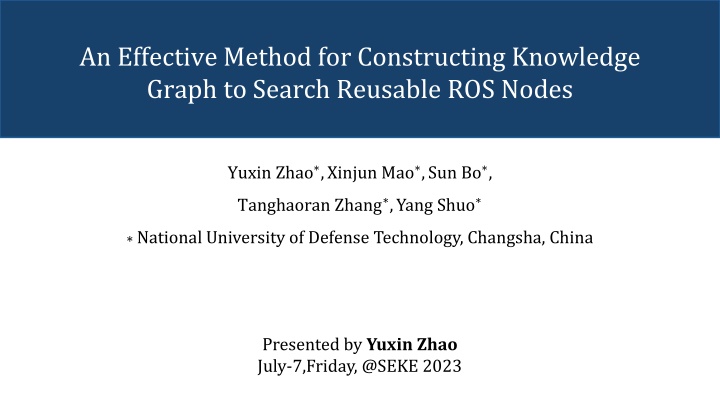
Efficient Method for Constructing ROS Node Knowledge Graph
Learn how to develop a centralized knowledge base using a knowledge graph to organize and search for ROS nodes efficiently, reducing development time for robotics software. Explore methods like ontology extraction and completeness assessment for effective knowledge management.
Download Presentation

Please find below an Image/Link to download the presentation.
The content on the website is provided AS IS for your information and personal use only. It may not be sold, licensed, or shared on other websites without obtaining consent from the author. If you encounter any issues during the download, it is possible that the publisher has removed the file from their server.
You are allowed to download the files provided on this website for personal or commercial use, subject to the condition that they are used lawfully. All files are the property of their respective owners.
The content on the website is provided AS IS for your information and personal use only. It may not be sold, licensed, or shared on other websites without obtaining consent from the author.
E N D
Presentation Transcript
An Effective Method for Constructing Knowledge Graph to Search Reusable ROS Nodes Yuxin Zhao ,Xinjun Mao ,Sun Bo , Tanghaoran Zhang ,Yang Shuo National University of Defense Technology, Changsha, China Presented by Yuxin Zhao July-7,Friday, @SEKE 2023
Background Robotics software development using ROS (Robot Operating System) Developing robotics software is time-consuming Reusing ROS Node is difficult [1] ROS ROSNodes Nodesare are scattered scatteredand anddifficult difficultto to acquire acquire [1] Kai Adam, Katrin H lldobler, Bernhard Rumpe, and Andreas Wortmann. Engineering robotics software architectures with exchangeable model transformations. In 2017 First IEEE International Conference on Robotic Computing (IRC), pages 172 179. IEEE, 2017. 2
Motivation How to store scattered knowledge of ROS Nodes and reduce the time developers spend for ROS Node search? Centralized knowledge base: organizing ROS Nodes and related documents. Based on knowledge graph knowledge graph. Search functionality: implanting a robust search engine. Based on knowledge graph embedding search methods knowledge graph embedding search methods. Community involvement: developers share knowledge within the repository. Based on community knowledge maintenance community knowledge maintenance. 3
Research Questions RQ1: How to build a knowledge graph of ROS Nodes ? RQ2: How to evaluate the quality of ROS Node knowledge graph ? 4
Methods Overall Framework 5
Methods The Ontology of ROS Node Knowledge Graph 6
Methods RQ1 - Extract ROS Node knowledge From structured files Based on ROS API: extract ROS Node names, ROS Topics, ROS Messages. From C++ files, Python files, XML files Based on ROS Wiki: extract ROS Packages, ROS repositories. From ROS Wiki, ROS Index, GitHub From unstructured files Based on dependency parsing: extract ROS functional tuples Based on NP-chunking: extract ROS related noun phrases 7
Findings RQ2: Completeness assessment of ROS knowledge extraction Protocol Protocol: : Analyze the source code or document to verify if any key ROS knowledge bas been missed. Table 1. The completeness assessment of ROS Knowledge extraction. Results Results: : Compared to the baseline approach, RNKG can successfully extract more than 90% of the key ROS Node knowledge. 8
Findings RQ2: Accuracy assessment of ROS knowledge extraction Protocol Protocol: : Evaluate whether the knowledge extracted from ROS Nodes is accurate and error-free. Table 2. The accuracy assessment of ROS knowledge extraction. Results Results: : Compared to the baseline approach, RNKG can correctly collect more than 80% of the key ROS Node knowledge. 9
Summary We have built a comprehensive and accurate knowledge graph of ROS Nodes. In the future, we plan to do in-depth follow-up research based on ROS Node Knowledge Graph. 10
Thank you July-7, Friday, @SEKE 2023 11
